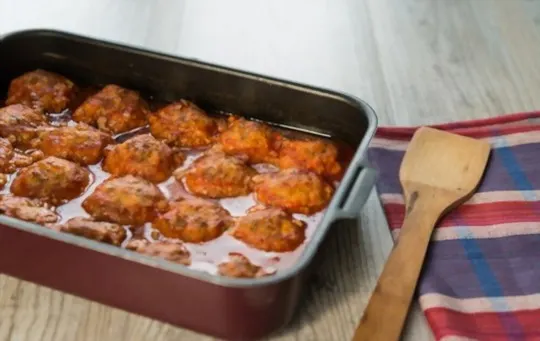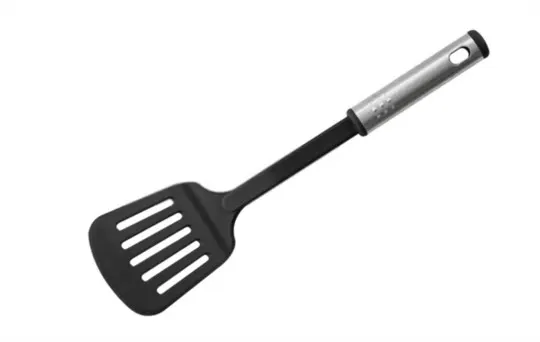In the kitchen wars, two utensils stand out: the spoonula and the spatula. These aren’t your average kitchen gadgets.
We’ve all been there, mixing, flipping, and scraping, trying to figure out which tool does the job best.
A spoonula, the hybrid hero, combines scooping and scraping powers. The spatula, on the other hand, flips like a dream. Each has its own claim to fame.
Sure, we could use a fork in a pinch (everyone has, right?).
Yet, understanding these tools can revolutionize your cooking game.
What is a Spoonula?

The Spoonula is a versatile kitchen tool that combines the features of a spatula and a spoon.
Its unique shape allows you to scoop, scrape, stir, and spread with ease.
The Spoonula is ideal for mixing cake batter, frosting cupcakes, sautéing vegetables, and serving rice or pasta dishes.
This utensil is made with silicone or rubber heads and can withstand high temperatures without damaging your non-stick cookware.
Another advantage of using the Spoonula over other utensils is that its flexibility allows you to get under foods without causing them to stick or break apart.
This makes it easier to transfer food from one location to another while prepping your meal.
In short, if you’re looking for an all-purpose kitchen tool that can handle multiple tasks with ease, then the Spoonula is an excellent choice.
Its versatility makes it perfect for any home cook or seasoned chef who wants to make their cooking experience more convenient and efficient.
What is a Spatula?

A spatula is a flexible tool used for flipping, turning, and transferring food while cooking.
Its flat and thin head makes it ideal for scraping the bottom of pans and bowls.
Typically made of metal or silicone, it comes in various shapes and sizes, including slotted and solid.
The handle can be straight or angled, providing comfort during use.
Overall, a spatula is an indispensable kitchen tool that every cook needs.
Moving on from the basic explanation of what a spatula is, it’s worth noting that there are different types based on their functions.
For instance, offset spatulas have long handles and angled blades that are suitable for frosting cakes or spreading batter evenly.
Slotted spatulas have perforations in the blade that allow grease or liquid to drain away from the food being lifted.
Fish spatulas are thin and flexible with a wide head designed to lift delicate fillets without sticking or breaking them.
In addition, some spatulas have specialized uses beyond cooking; for example, laboratory spatulas are used for handling chemicals while cream spatulas help remove excess product from makeup containers.
To conclude, while many people use the term ‘spatula’ interchangeably with other kitchen utensils like turners or scrapers, its unique design ensures versatility in the kitchen compared to other tools specifically intended for one purpose.
Differences Between Spoonula and Spatula

Spoonula and spatula are kitchen utensils used for cooking purposes.
However, they have unique differences that distinguish them from each other.
While both have flat heads, Spoonula has a deeper scoop shape head while spatula’s head is wider and flatter.
The spoonula’s deep scoop shape makes it suitable for scooping ingredients in mixing bowls while the spatula works best for flipping pancakes, eggs or burgers on frying pans.
Design and Shape
The construction and outline of spatulas and spoonulas are different.
The former typically has a flat, elongated design with a straight edge, while the latter has a combination of spoon-and-spatula-like shapes.
When preparing various baked goods like cakes and brownies, for example, spatulas are excellent tools for smoothing out the final layers of batter.
On the other hand, spoonulas are more effective at scraping ingredients together and can be utilized to stir delicate mixtures without damaging them in any way.
Additionally, their silicone or rubber tips can withstand higher temperatures than traditional plastic or wood cooking utensils.
Functionality and Use
Spoonulas and spatulas are integral tools found in every kitchen.
The functionality and use of each differ slightly.
Spoonulas possess a wider and deeper bowl, making them ideal for mixing and scraping batters, sauces, and soups thoroughly.
While spatulas have a flat, narrow blade making them ideal to fold ingredients together gently, flip pancakes, eggs or burgers on the grill or skillet.
Both tools are versatile and have their uses depending on the recipe.
In addition to their distinct shapes, these tools come in various materials such as wood, metal or silicone.
Wooden spoons do not conduct heat; thus makes them ideal for cooking hot dishes like sauces but can become discolored over time.
Silicone utensils do not scratch or ruin non-stick surfaces making them essential for processing delicate foods but cannot withstand substantial high heat levels.
Metal utensils can handle high temperatures without getting damaged allowing any cook to process meats in a skillet.
The right tool’s choice is something cooks often overlook while preparing their meals.
Having an understanding of each tool’s capabilities brings out the best flavors from each dish with ease.
Consider safety measures while using metal cookware as it heats up quickly while still touching handles might damage your hands resulting in burns.
Finally, reading care instructions for different types of utensils ensures that they last long and maintain their appearance year after year without requiring frequent replacements.
Material and Heat Resistance
When it comes to kitchen tools, material and heat resistance are crucial factors to consider.
Utensils such as the spoonula and spatula differ in these aspects.
Spoonulas are typically made of silicone or rubber, which can withstand high temperatures up to 500°F, making them perfect for baking or cooking with non-stick cookware.
On the other hand, spatulas come in a variety of materials such as metal, wood, and plastic but may not be suitable for use in high-heat settings.
Metal spatulas can conduct heat, while wooden and plastic ones may melt when exposed to high temperatures.
In addition to material and heat resistance, another essential factor to consider is the purpose of the tool.
Spoonulas are designed with a rounded end that allows them to scrape every last bit of food out of bowls and containers.
Meanwhile, spatulas usually come with a flat surface that makes it easy to flip pancakes or stir ingredients evenly.
Overall, both utensils have their unique advantages depending on what you’re cooking.
It’s important to choose the one that’s best suited for your needs based on its material composition and heat resistance capabilities.
By taking these factors into consideration, you’ll be able to select the perfect tool for each culinary task without compromising flavor or functionality.
Similarities Between Spoonula and Spatula
The spoonula and spatula share some similarities in terms of purpose and design.
Both kitchen tools are versatile and designed to mix, scrape, and spread food.
They also have a flat surface with a thin edge, allowing for efficient movement from bowl to pan.
Though the shapes may vary slightly between brands, both utensils are typically made from silicone or heat-resistant plastic, making them safe for use with hot liquids or on non-stick surfaces.
While they share many similarities, there are still distinct differences between the spoonula and spatula that make each tool unique.
For example, while the spoonula features a curved shape with a spoon-like indentation on one side, the spatula is straight with a wider base.
This slight variation in shape can affect how well certain tasks can be accomplished – the spoonula is generally better suited for mixing ingredients in curved-bottomed bowls or scraping the sides of jars and containers, while the larger surface area of a spatula may be better for flipping pancakes or burgers.
In summary, while both the spoonula and spatula serve similar purposes in the kitchen, their slight design variations make them useful for specific tasks.
Understanding these differences can help home cooks choose which tool will be best suited for their needs as they prepare meals in their kitchen.
How to Choose Between a Spoonula and Spatula?

When it comes to selecting the right kitchen tool for your next meal, the decision between a spoonula and spatula can be daunting.
But fear not, as we explore the differences and help you choose wisely.
- Consider what you’ll be cooking; if handling high-heat foods, opt for a heat-resistant spoonula or spatula.
- Review the consistency of your dish; if thicker or stickier, a spoonula’s curved edges will aid in scooping and stirring. But if flipping items is common in your recipe, use a flat-edged spatula for optimal results. Remember to prioritize durability and ease of cleaning when making your ultimate choice.
It’s important to keep in mind that each utensil has its strengths and limitations.
A spoonula combines the best features of a spatula and mixing spoon while providing flexibility like no other tool.
This makes it an excellent choice for dishes that require both stirring and scooping – think soups and stews.
Meanwhile, a traditional spatula’s flat edge excels at getting under delicate foods like fish fillets or cookies to ensure they don’t break apart during flipping or removing from the pan.
Ultimately, choosing between these two essential kitchen tools comes down to what you’re cooking and personal preference.
Experiment with both options to determine which works best for you in various recipes.
Remember to prioritize comfort in your hand and ease of use when selecting a new spoonula or spatula – happy cooking.
Additional Considerations for Spoonula and Spatula
When it comes to kitchen tools, the spoonula and spatula are often confused with one another.
However, both have unique features that differentiate them.
The spoonula’s silicone head is curved on one side like a spoon while its opposing edge has a straighter edge like a spatula.
On the other hand, the spatula is mostly flat with edges that can vary from straight to slightly curved.
In terms of functionality, considering the ingredients you’re using can help you decide which tool to use.
For instance, if you’re working with thick batters like brownies or cookie dough, the spoonula’s flexibility makes it easier to scoop every last bit out of your bowl.
Meanwhile, flip delicate items such as eggs or pancakes using a thin-edged spatula instead of stove tongs.
It is also important to note that not all spoonulas or spatulas are created equally; they vary in size, shape, materials, and design.
Some manufacturers produce oversized models while others opt for slender ones – there’s no right or wrong choice here–it’s just a matter of personal preference.
To make sure you’re getting what you need as per your requirement whether it’s flipping an egg without breaking its yolk or scraping every last drop from your mixing bowl – choose quality kitchen tools that feel comfortable in your hand and make cooking a breeze.
Conclusion
The differences between a spoonula and spatula are nuanced.
While both tools are designed to stir, mix and scrape ingredients in a bowl or pot, they vary slightly in shape and composition.
A spoonula is usually made of silicone or rubber with a shallow scoop-shaped head that’s attached to a handle at a steep angle; whereas, spatulas can have different shapes, including offset, flat, slotted, or fish-style with one long edge and one short edge allowing for increased control when flipping food.
In terms of functionality, spoonulas are great for scooping and spreading thick substances, while spatulas are more versatile and ideal for an array of cooking tasks from stirring delicate sauces to flipping heavy duty pancakes.
It all comes down to what you’re cooking – for creamy pasta sauces go for a flexible spoonula with rounded edges but for seared steaks opt for sturdy metal-topped spatulas to help prevent scraping on the pan.

Leave a comment